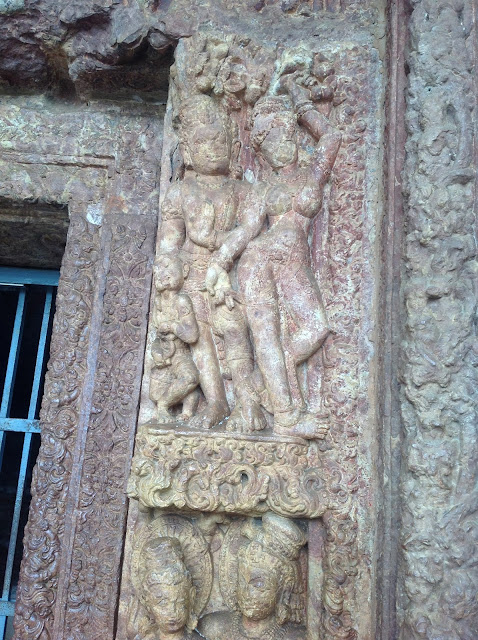On Sirpur Excavations - Part II.
The Laxman temple of Sirpur is an archaetectural marvel, especially from aesthetic perspective. Laxman is the brother of Lord Rama (of Ramayana epic). This temple is supposedly the only temple in India dedicated to Rama's brother, Laxman. Another characteristic of the Laxman temple (besides its archaelogical significance as it is dated 6th C.E and constructed by South Kosala dynasty) is that it is made from red burnt bricks. The original color of the temple seems to be white as evident from the left over white color on the outside of the temple bricks.
(All images are copyrighted by Urmila Duhan. Kindly obtain permission before using them).

The photo below in white has been artificially colored white (Adobe Photoshop) as the original color of the temple was white as a result of white plastering on it. The photograph gives a comparison of how it is now (red bricks) compared to how it looked in original state. (Thanks to Mr. S.K. Sharma of A.S.I for coloring the photo white for me).

The board erected by the ASI at the temple site is shown below. It gives details about the historical and archaeological significance of the site and also it's geographical location.


Above photo shows the outside view of Laxman Temple, Sirpur, Chattisgarh, India.
The mythological reason for naming it Laxman temple even though it is largely dedicated to Lord Vishnu's protector (shesh naag i.e., snake canopy over lord Vishnu) is that Lord Rama is considered an avatar (re-incarnation) of Vishnu and the shesh naag is Vishnu's forever companion and protector. The Shesh Naag therefore also re incarnated as Vishnu's companion and protector in the form of lord Rama's brother, Laxman. Laxman fiercely protected his brother Rama during Rama's exile period as detailed in the epic Ramayana.
The entrance to the temple has remnants of multiple pillars (seen as seat shaped carved stones in light brown and dark brown color). Thus the temple was more elaborate in structure compared to its current form.

Polished couple images (in meditative hand postures and otherwise) on the entrance door. On careful examination, all images of the female are without a 'bindi' on their forehead. It therefore seems that the current fashion of applying a 'bindi' on forehead by women especially if married, is a social phenomenon that perhaps took place in the later era i.e., 12th C.E and later as per my observation. Women in 6 C.E also did not mandatorily cover their head/face with a veil, as it is customary in rural India these days. Men preferably remained clean shaven.
 The woman in the above image is shown holding mango tree branch and the man in gyan mudra. They are lovers/couple as evident from their feet touching each others.
The woman in the above image is shown holding mango tree branch and the man in gyan mudra. They are lovers/couple as evident from their feet touching each others.
 The outer, exposed facade of the temple shows white colored plaster over the red bricks, that is now almost completely gone, except few patches here and there. It is amazing though that the bricks have withstood all kinds of weather through so many centuries without the protective plaster layering.
The outer, exposed facade of the temple shows white colored plaster over the red bricks, that is now almost completely gone, except few patches here and there. It is amazing though that the bricks have withstood all kinds of weather through so many centuries without the protective plaster layering.

A long shot of Laxman Temple with monsoon clouds in the backdrop and lush greenery surrounding it. A very pleasant sight indeed!

Photographs showing decorations on the outer temple walls. The temple must've looked very attractive in white color as well, i think.


 This is indeed a very beautiful temple! Here the nobleman is shown with a halo and the woman that he is holding must also be noble as she also has a halo around her head. Parrot, a symbol of love and truthtelling, is shown perched on the womans side and seems to be communicating with the man (as evident from its open beak). The man seems to be in a pleasant mood as evident from the slight smile on his face. To some it may appear that that the man is trying to pull the woman closer to him. Perhaps, there may have been a tiff between them as the woman is not smiling and requires the man to pull her closer! (Thank you Dr. Subodh Mittra (of ASI, New Delhi) for sharing your thoughts on iconography with me).
This is indeed a very beautiful temple! Here the nobleman is shown with a halo and the woman that he is holding must also be noble as she also has a halo around her head. Parrot, a symbol of love and truthtelling, is shown perched on the womans side and seems to be communicating with the man (as evident from its open beak). The man seems to be in a pleasant mood as evident from the slight smile on his face. To some it may appear that that the man is trying to pull the woman closer to him. Perhaps, there may have been a tiff between them as the woman is not smiling and requires the man to pull her closer! (Thank you Dr. Subodh Mittra (of ASI, New Delhi) for sharing your thoughts on iconography with me).

On closer examination of the video posted above, one maybe able to see the undulating motion of a snake that is moving along the crevices between white horizontal floor and dark brown vertical rocks/bricks. This constructed portion surrounds the Laxman temple.













No comments:
Post a Comment